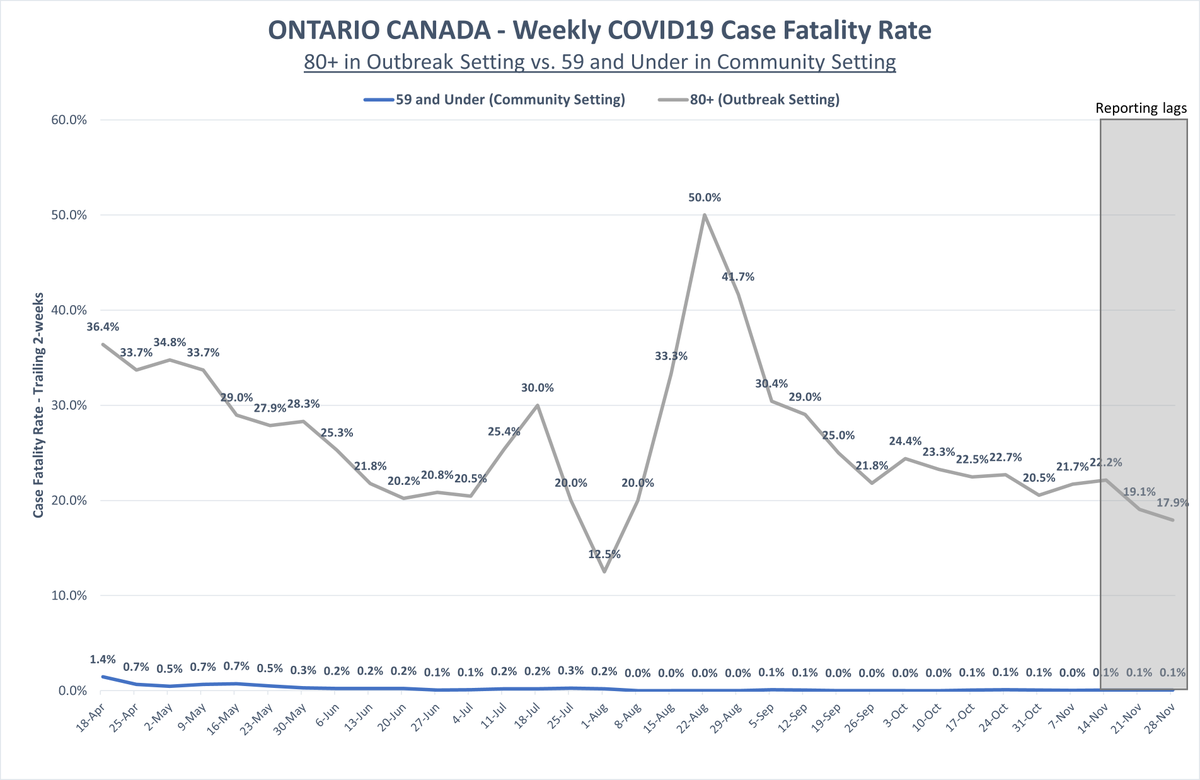
1/ @globaandmail article today comparing #COVID19 in Toronto and Ottawa, headlined, “Two pandemics”.
In this brief thread will show, with simple data, why this article, in my view, is way off the mark. theglobeandmail.com/politics/artic…
In this brief thread will show, with simple data, why this article, in my view, is way off the mark. theglobeandmail.com/politics/artic…
2a/ First, let’s dispel the article’s basic premise:
“The COVID-19 pandemic worsens in [Toronto], even as the situation steadily improves in the nation’s capital.”
While many areas of Toronto are struggling w/cases, roughly half of Toronto’s 140 neigh’hoods are flat/declining.
“The COVID-19 pandemic worsens in [Toronto], even as the situation steadily improves in the nation’s capital.”
While many areas of Toronto are struggling w/cases, roughly half of Toronto’s 140 neigh’hoods are flat/declining.

2b/ And here’s the kicker:
Those ~70 Toronto neighbourhoods w/flat or declining cases (appear to be past their peak), including the 13 hoods of Downtown Toronto,
*ARE TRACKING OTTAWA ALMOST EXACTLY*
Those ~70 Toronto neighbourhoods w/flat or declining cases (appear to be past their peak), including the 13 hoods of Downtown Toronto,
*ARE TRACKING OTTAWA ALMOST EXACTLY*

2c/
Same chart as 2b, just showing Downtown Toronto (~302,000 people), vs. Ottawa (~1m people), just to drive home the point and the nuance.
Same chart as 2b, just showing Downtown Toronto (~302,000 people), vs. Ottawa (~1m people), just to drive home the point and the nuance.

3/ The article goes on to talk about the reasons why Ottawa is(?) fairing better than Toronto…
4a/ Geography: “Geography is one factor. Canada’s national capital has much lower population density than its financial capital.”
While true (Toronto denser than Ottawa), there is negative/no correlation between neighbourhood population density and neighbourhood cases per 100/k
While true (Toronto denser than Ottawa), there is negative/no correlation between neighbourhood population density and neighbourhood cases per 100/k

4b/ Geography: “’If you have a less dense population, the disease will not spread as quickly or as intensely,’ says @deonandan”
While perhaps true at a citywide level, downtown TO has ~11,454 people per sq km (36x that of Ottawa), while its cases are *exactly tracking* Ottawa’s.
While perhaps true at a citywide level, downtown TO has ~11,454 people per sq km (36x that of Ottawa), while its cases are *exactly tracking* Ottawa’s.

5a/ Transit: “B/c public transit in [Ottawa region] is mediocre…only 18% [ride] public transit to work…for Toronto…the figure was 24%.” -Ibbitson
In Toronto, we see public transit ridership prevalence in a neighbourhood *does not correlate* with neighbourhood cases per 100k.
In Toronto, we see public transit ridership prevalence in a neighbourhood *does not correlate* with neighbourhood cases per 100k.

5b/ Transit: interestingly, as a side note, while public transit riding prevalence in a neighbourhood itself does not correlate to cases per 100k, average commuting time (in minutes), pub transit or not does seem to have some weak positive correlation to cases per 100k. 

6a/ Outdoor Culture: “The capital is well known for its outdoors culture…there are plenty of bike paths, and the 361sq kms of Gatineau Park are only 4kms from Parliament.” - Ibbitson
6b/ Outdoor Culture: Does anyone in Toronto reading this post think that TO has any less of an “outdoor culture” than Ottawa? TO has some 558kms of bike lanes/tracks and 297kms of off-road trails vs. Ottawa’s ~350kms of multi-use lanes (~same per capita). 



6d/ Outdoor Culture: Ibbitson goes so far as to say, “a pop with greater access to such rec activities is less at risk from the complications that can force people with COVID19 into hospital.”
Essentially implying (w/out evidence) Torontonians are at > risk for complications.
Essentially implying (w/out evidence) Torontonians are at > risk for complications.
7a/ Major Airport Hub: “The fact that Toronto Pearson Airport is a major airline hub and Ottawa International Airport isn’t could be a factor. Cities with hub airports tend to have higher infection rates, despite travel restrictions.” - Ibbitson
7b/ Major Airport Hub: I can’t really dispute this, and I may agree with it, but there is no proof or data offered to support this view.
Maybe look at case rates in major airport city hubs (Atlanta, Dallas, Denver, Chicago, etc.) and compare them?
Maybe look at case rates in major airport city hubs (Atlanta, Dallas, Denver, Chicago, etc.) and compare them?
8a/ Workforce makeup: “Some sectors of our (Ottawa’s) economy work from home more easily.” – Dr. Etches. And Ibbitson: “Toronto’s economy is more mixed, and includes more people working in low-paying jobs outside the home.”
8b/ Workforce makeup:
Well, I agree! As I’ve shown extensively, neighb’hood cases/100k & other measures strongly correlate with lower-income neighb’hoods and service workforces, while they negatively correlate with work-from-home neighbourhoods.
Well, I agree! As I’ve shown extensively, neighb’hood cases/100k & other measures strongly correlate with lower-income neighb’hoods and service workforces, while they negatively correlate with work-from-home neighbourhoods.
https://twitter.com/rubiconcapital_/status/1329227856468172800?s=20
8c/ Workforce makeup: It is nice to see Dr. Etches and the @globeandmail and @JohnIbbitson indirectly acknowledging and speaking publicly about the same concepts that the nice people that founded the @gbdeclaration have been speaking about for months. 



8d/ Workforce makeup: “Public servants may, by their very nature, comply more readily with government directives than workers in the private sector. “I can’t prove that, but there’s a sense that maybe Ottawans are better followers than Torontonians,” -@deonandan
8e/ …well, I’d suggest if you can’t prove it, don’t say it, and as such, if you’re a national paper, don’t print it. 

9/ So in sum, hopefully I’ve provided some useful context and perspective so that the Toronto and Ottawa comparison can be viewed through a more nuanced lens.
End thread.
End thread.

/addendum: note that for brevity and 280 character fit I have abbreviated some of the quotes, but their essence was unchanged. I don't have license to post screenshots of the entire article from behind the paywall, so I did not do so.
• • •
Missing some Tweet in this thread? You can try to
force a refresh














